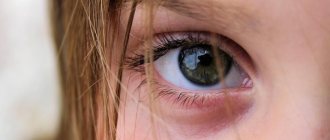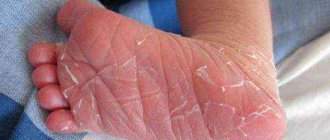Why does my child have bags under his eyes?
If swelling occurs regularly in the baby, parents should consult a doctor. It is quite difficult to determine on your own whether a sign is a violation of the daily routine or a pathological process in the body. You can find out why your child has bags under his eyes after a comprehensive examination. Swelling is not always a consequence of the disease; swelling is more often caused by eating habits and sleep.
Causes of bags under the eyes in children:
- Violation of the water-salt balance is manifested by characteristic swelling of the eyelids, usually occurring in the first half of the day, and noticeably decreases in the evening.
- Lack of proper rest, skipping daytime sleep by preschoolers, and disruption of night sleep negatively affect overall well-being.
- Spending a long time in front of a computer monitor, TV, reading books, constant stress on the visual system is a common cause in school-age children.
- Allergies to food, household chemicals, dust, plants; in addition to swelling, a rash, itchy skin, and dry cough may occur.
- Malfunctions of the kidneys, parents are advised to consult a doctor if there are changes in urination, a significant decrease or increase in the frequency of urges, or lower back pain.
- Disorders of cardiovascular activity can be suspected if the child gets tired quickly, shortness of breath appears, and swelling of the lower extremities occurs.
- The genetic feature is the growth of fiber and sagging of the thin skin of the eyelids.
- Inflammatory processes of the respiratory system and eyes are accompanied by redness of the mucous membrane, difficulty breathing, lethargy, and fever.
Treatment
Treatment, if necessary, is selected individually based on these diagnostic measures. If swelling of the eyelids is a sign of any disease, then treatment will be aimed at eliminating it, and the swelling will go away on its own over time. If swelling is a consequence of a violation of the daily routine, then this symptom will go away without treatment after it is established (proper nutrition, proper sleep).
Drug therapy
Medicines are prescribed if swelling of the child's lower eyelids is caused by illness. At the same time, remedies can be prescribed that will help eliminate this cosmetic defect externally.
The most commonly prescribed drugs are:
- Tetracycline ointment, Furacilin solution, Tobrex drops, oletethrin ointment for conjunctivitis.
- Antihistamines: Allergozan ointment, Loratadine, Histimet eye drops. Other drops can also be used. Here you can find a list of the best drops for treating eye swelling.
- Blefarogel is a cosmetic ointment that accelerates the disappearance of swelling of the eyelids, but is permissible for use only from 14 years of age.
- Levomycetin is an eye drop that is prescribed for barley or blepharitis.
- Palin, Nitroxoline, Monural are prescribed for dysfunction of the urinary system.
- For sleep disturbances, sedative drops (motherwort, valerian) or teas are prescribed.
- A course of vitamin preparations.
- Preparations for replenishing iron (for iron deficiency anemia): Sorbifer, Biofer, Ferrum Lek.
The appropriateness and duration of use of certain drugs is determined by the doctor. Self-medication is not acceptable.
ethnoscience
Folk remedies are also effective for eliminating bags under a child’s eyes. But here, too, caution will not hurt: individual intolerance to the components contained in plant raw materials can lead to an allergic reaction.
Traditional medicine methods for relieving eyelid swelling:
- Brew 2 tea bags, cool until warm (comfortable for the skin of the eyelids) and apply to the child’s closed eyes. Wait 15 minutes. This is an effective method with instant results.
- Peel the fresh cucumber and grate the pulp. Squeeze out just a little liquid from the resulting slurry, and then apply to the area of swelling under the eyes. Leave for 10 minutes.
- Brew chamomile flowers in boiling water. The broth should be cool. Cool the liquid, then pour it into ice cube trays and freeze. Every morning, wipe the child’s swollen eyelids with an ice cube. Plain ice has a similar effect.
- Soak the crumb of black or white bread in heated milk - you should get a paste that is not too thick and not too thin. It is applied over swollen eyelids and left for 25 minutes.
- Prepare a decoction of rose hips. Cool to a comfortable temperature and give the child a drink. You can sweeten the drink with a little honey or sugar. The decoction has an excellent diuretic effect and also supplies the body with vitamin C.
- Grate raw potatoes. Wrap the pulp in thin gauze and apply it to the child's eyes. Leave for 20 minutes. Then wash your face with warm water and lubricate the skin around the eyes with a light baby cream.
- A sour cream and curd mask will help remove swelling from the eyelids. It is prepared in a 2:1 ratio (cottage cheese and sour cream, respectively). The mass is placed in gauze and applied to the eyelids for 15 minutes. Practice has shown that this method is safe and effective for the delicate skin of the eyelids of newborns.
After using the lotions, juice remains on the eyelids. It should not be washed off immediately: it is better to gently rub it into the skin with massaging movements of your fingers and only then rinse with water.
The child has bags under his eyes in the morning after sleeping
Often parents may not notice the reasons for the appearance of swelling in the baby. Before seeking medical help, it is worth analyzing your daily routine, eating habits, and sleep. By eliminating some provoking factors, you can cope with the problem.
Why does a child have bags under his eyes in the morning after sleeping?
- Children often like to drink just before bed, which leads to a natural accumulation of fluid,
- Tears at night often result in swelling in the morning, so it is important to ensure that your baby has a quiet time in the evening,
- early rises, constant changes in daily routine,
- incorrect position during rest, the head should be slightly higher than the body,
- lack of a balanced diet, deficiency of important vitamins and microelements, insufficient amounts of fresh vegetables, fruits, meat, and dairy products in the diet.
If swelling regularly appears in babies under one year of age, this may be a sign of increased intracranial pressure. The child behaves restlessly, often cries, and is capricious for no apparent reason. If changes in behavior occur, you should contact a neurologist for diagnosis and treatment.
Foreign object, injury
This is the most common cause of puffiness under the eyes in babies. Children are very inquisitive and can look in search of “the most interesting things” in hard-to-reach places where dust and small debris accumulate. It is the speck that can get into the eye and begin to mechanically affect the mucous membrane, provoking the beginning of the protective work of the fiber. Even when the speck has already been washed out of the eye by the tears that have appeared, the fiber will remain “on guard” for a long time.
In the same way, a baby can simply poke his eye with a finger or a toy. When searching for a foreign object, parents will not find anything and will begin to worry about swelling.
If the cause is minor mechanical damage, then literally in a couple of hours the bags will go away. If this does not happen, you need to show the baby to a doctor, first of all, an ophthalmologist. A not very large speck that was difficult to see could have gotten into the eye. If the specialist does not find a foreign object, you will have to visit a pediatrician.
Red bags under the eyes of a child
Changes in eyelid skin color and swelling are not always a cause for concern. It is important to pay attention to the accompanying signs, which allow us to understand the causes of bags under the eyes of a child and treatment to restore a normal state.
Why do red bags appear under a child’s eyes?
- An infectious disease, in addition to redness, digestive disorders are observed, and body temperature rises.
- Difficulty breathing is a symptom of inflammation of the tonsils.
- In infants it can be associated with teething; children under six months often suffer from colic; after crying, the skin of the eyelids naturally turns red, and goes away on its own within a few hours.
- Red circles under the eyes are a reason to see a dentist; they often become a sign of inflammation in the oral cavity.
- If redness appears regularly, it is worth getting tested for helminths, especially if there are animals in the house.
- Vegetative-vascular dystonia is also manifested by paleness of the face, periodic headaches, the child constantly feels tired and drowsy.
- Diseases of the organs of vision, the baby may complain of discomfort, headache, it is important to consult an ophthalmologist in a timely manner to eliminate dangerous consequences.
Home Recipes
If there is a disease, the doctor will prescribe therapy. If the reason is different, then you can relieve swelling with folk recipes that will not harm the baby. These methods can also be used in complex therapy - medications fight the disease, and herbs fight swelling!
- Prepare the chamomile decoction according to the instructions on the package, moisten cotton pads and wipe the child’s eyes.
- Potato starch quickly relieves swelling: peel and cut the potatoes into circles, apply to the baby’s eyelids.
- Like potatoes, cucumber juice helps. If the baby does not allow you to keep the potatoes on his eyes, then grate the cucumber, dip the cotton wool in the juice and wipe the baby’s eyes.
- Apply pre-brewed and cooled tea bags.
- Rub small amounts of almond oil into the skin under your eyes once a day.
Blue bags under the eyes of a child
Children of any age can develop dark circles under their eyes. In infants, it is often associated with a period of adaptation, teething, and painful colic. If the blue bags under the eyes of a child do not go away on their own, this is a reason to contact a pediatrician; you may need to consult a specialist. In preschoolers, they appear when tired, often as a consequence of a blow, fall or bruise, after actively exploring the world. In children after 7-8 years of age, the load on the visual system increases due to the beginning of the educational process. The blueness of the lower eyelid increases if your free time is spent watching cartoons or playing computer games.
What diseases lead to the appearance of blue bags:
- anemia, more common during the off-season,
- a symptom of endocrine disorders, possible weight fluctuations, unexplained mood swings,
- adenoids, sinusitis and other pathological processes of the respiratory system,
- malfunction of the kidneys,
- infection by parasitic microorganisms – worms,
- intoxication of the body due to liver dysfunction,
- metabolic imbalance.
The causes and treatment of bags under the eyes of a child require preliminary diagnosis. Only an integrated approach will speed up the recovery of the body.
Dr. Komarovsky - causes of edema in a child
A well-known pediatrician advises parents not to panic ahead of time. If this is not a feature of your appearance, you should consult a doctor. After the examination, blood, urine, and stool tests are prescribed. If kidney pathology is suspected, the genitourinary system is examined using ultrasound. If abnormalities are detected, the pediatrician refers for further treatment to a nephrologist.
If urine analysis and kidney ultrasound do not reveal any abnormalities, the child is referred to a cardiologist. The doctor measures blood pressure, and if indicated, the patient undergoes a cardiogram, ultrasound of the heart and blood vessels.
If an allergic reaction is suspected, allergy tests are performed to identify the causative agent. More often, when the provoking factor is eliminated, the child’s condition improves. In some cases, antihistamines are prescribed.
Swelling may be a sign of worms; stool analysis will reveal the presence of parasites in the body. In addition to the baby, all family members will have to undergo drug therapy; there is a high probability of infection through pets.
Dr. Komarovsky encourages parents to maintain common sense; if swelling appears from time to time, the child’s daily routine, sleep, and nutrition should be analyzed.










